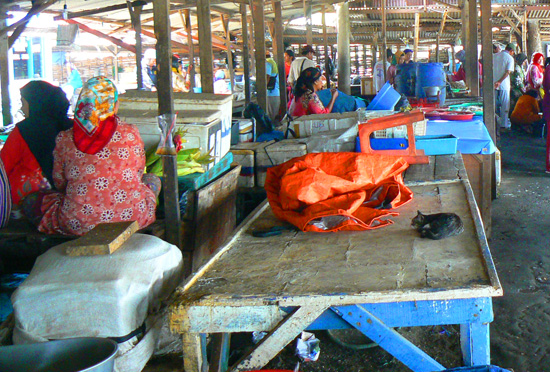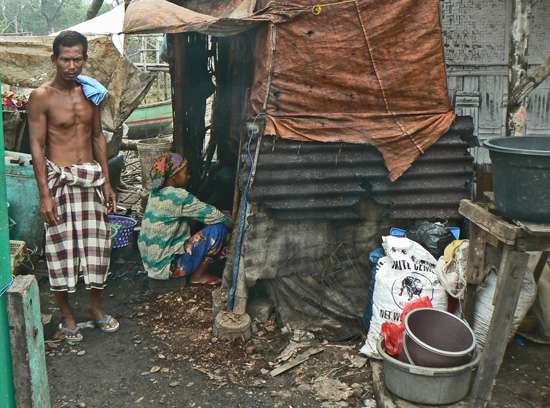The true costs of prawn farming are starting to show in Java
John McLachlan-Karr
This local fisherman now struggles to make a livingJohn McLachlan-Karr |
Every time I fly out of Surabaya I am amazed by the way the coastal region has been almost entirely transformed into a patchwork of prawn ponds. According to GIS data obtained during a recent AusAID and United Nations assessment of the impacts of the Sidoarjo mud flow, 95 per cent of the mangrove forests and estuarine creeks that once lined the coast have been developed into prawn ponds. Despite initial fears, the nearby mud flow has not had a direct impact on the Sidoarjo ponds, but even before the disaster the prawn farms were already in decline.
Twenty-five years of prawn farming has degraded the ecosystem, to the extent that the Javanese coastal region is now struggling to support the production of both farmed prawns and wild seafood. While for many years these ponds produced lucrative harvests, overdevelopment is now causing decreasing returns to scale, and the environmental and socio-economic consequences of the ponds are becoming more apparent.
Gold rush for prawns
Back in the 1990s, I saw similar coastal scenes in the South American country of Ecuador, where commercial prawn farming started over forty years ago. Sometime in the late 1960s, banana plantation owners noticed that floodwaters trapped behind a levee produced large populations of sizable prawns. People quickly began to engineer the process by creating artificial ponds and by the early 1970s prawn farming was growing fast in Latin America. The concept of prawn farming soon spread to Asia: first to Taiwan, Thailand and the Philippines, then to Indonesia and Vietnam, where labour and land were cheaper, coastal areas more fertile and regulations more flexible. Considering the apparently insatiable demand for prawns in Australia, Japan, Hong Kong and Europe, it looked as if the boom would continue as long as suitable areas for ponds could continue to be developed.
Responding to the demand, during the 1980s entrepreneurs borrowed money from international development banks to cover the costs of the prawn farm set up in Indonesia. Establishing a prawn farm involves clearing the natural mangroves, after which channels surrounding the pond are dug and the excess mud then moulded into dykes. Pumps are installed in an attempt to artificially regulate the hydrology of the mangrove system and a packing plant is established nearby so the prawns can be quickly prepared for export. The initial loans for the prawn farm setup were normally repaid in a couple of years and the cost of the land itself was cheap – most of the ponds were dug on publicly owned, coastal wetlands and required only minimal rent to be paid to the Ministry of Marine Affairs and Fisheries. In the 25 years since prawn farming started, what used to be estuaries and creeks have now mostly been reduced to narrow irrigation channels and every part of the Sidoarjo Regency’s 44 kilometres of beach is subdivided into ponds, making the transition from land to sea nearly indistinguishable from the air.
Although the prawns themselves were always too expensive to be enjoyed by most locals, the aquaculture boom provided a substantial boost to the economy of the Sidoarjo Regency and attracted many people into the region. Even traditional fishermen, long one of the most economically disadvantaged groups in the area, were able to benefit from the boom, earning the equivalent of a month’s wages in just a few nights by catching juvenile or egg-bearing female prawns from nearby creeks to be used for hatchery stock. There were other trickle-down economic benefits, too, as the boom supported the development of a subsidiary industry supplying prawn feed and the expansion of the prawn by-products industry which produces the now famous Sidoarjo krupuk.
Problems with productivity
When the Sidoarjo prawn farms were first established in the late 1980s, a single hectare was able to produce up to 10 tons of black tiger prawns for export, generating roughly $A 195,000. But prawn yields have declined drastically, with all 1800 hectares of ponds in Sidoarjo Regency only yielding about 20 tons of prawns in 2006. Over the years, prawn farmers have attempted to boost naturally decreasing productivity by applying prawn feed to stimulate algae growth in the ponds. But the stagnant, nutrient enriched ponds they produced also provide a fertile environment for disease-causing pests. Disease outbreaks now occur frequently and – with the prawns’ genetic variety weakened by hatchery stock – can decimate a whole year’s prawn production in weeks. Prawn farmers have recently attempted to control these epidemics by adding chemicals, and by circulating the pond water with more frequent pumping, but this too has proved ineffective and has added pressure to already increasing costs.
It is not just the prawn farms that are suffering. Because the surrounding environment has been plunged into imbalance by unsustainable aquaculture practices, livelihoods and traditions are also in jeopardy. The removal of natural organic matter that occurs when the ponds are dug means there is no longer a mechanism for filtering excess salt from the groundwater, a change which has affected the quality of drinking water from wells throughout Java and has hurt rice farmers, who depend on the natural water supply for irrigating their crops. Removing the organic material also causes the land to sink – a process which has resulted in widespread flooding across coastal Java.
 |
The local fish market no longer thrives as it once didJohn McLachlan-Karr |
At the same time, primary production in the coastal wetlands is causing a decline in the yields of ‘wild’ coastal fisheries, forcing fisherman to travel further and fish for longer to catch the same amount. In Surabaya, a city once known for its seafood, the local fish supply is getting scarcer and more expensive. According to Pak Yudi, a local fisherman I spoke to at the Gisikcemandi fish market, the market stalls used to have tables laden with sea-caught prawns, quality fish and crabs for a few thousand rupiah per kilo. Now, the return from his catch now barely covers the cost of fuel. Perhaps responding to the increasing costs of wild seafood, prawn thievery from the ponds is becoming an increasing problem – most of the brown tiger prawns for sale at the local markets in Sidoarjo have been stolen from the ponds under the cover of darkness. But even these black market prawns, sold at around Rp. 45,000 per kilogram, are still too expensive for most Indonesians.
Finding the balance
The preliminary assessment undertaken by the joint AusAID and United Nations Environment Program – which considered the function of mangrove forests and economic data from the prawn industry in the Sidoarjo Regency – indicated that only around 25 per cent of the mangrove area should be used for intensive prawn farming if maximum, long term production is to be maintained. The local government should develop and implement sustainable policies to ensure that the environmental balance protected in this manner.
In the meantime, some solutions are emerging organically. The decline in supply of wild-caught fish and pond prawns is already promoting a shift to the production of more sustainable local aquaculture fish like the hardy bandeng (a kind of giant herring traditionally used in Javanese ponds) and mujair (a tilapia). Often the juveniles of these species enter the ponds of their own accord, avoiding the need for the costly, hatchery supplied stock and making the end product locally affordable. These species can also survive the poorer water quality and grow faster than prawns without the need for commercial feeds or chemicals. A similar shift has occurred in Latin America, where the aquaculture industry has moved away from a monoculture of high priced prawns, instead concentrating more on sustainable local species.
The experience there and in Sidoarjo demonstrates yet again that finite ecosystems are unable to support prolonged economic ‘booms’ and will inevitably shift back down to their natural capacity. In other words, the ‘no free lunch’ rule continues to apply even when there are tiger prawns on the menu.
John McLachlan-Karr (john.mclachlan-karr@bg-group.com) is a consultant for ITS in Surabaya and was the Technical Team Leader for the recent AusAID and United Nations Environment Program Assessment of the Lapindo mud volcano disaster in Sidoarjo, East Java.



